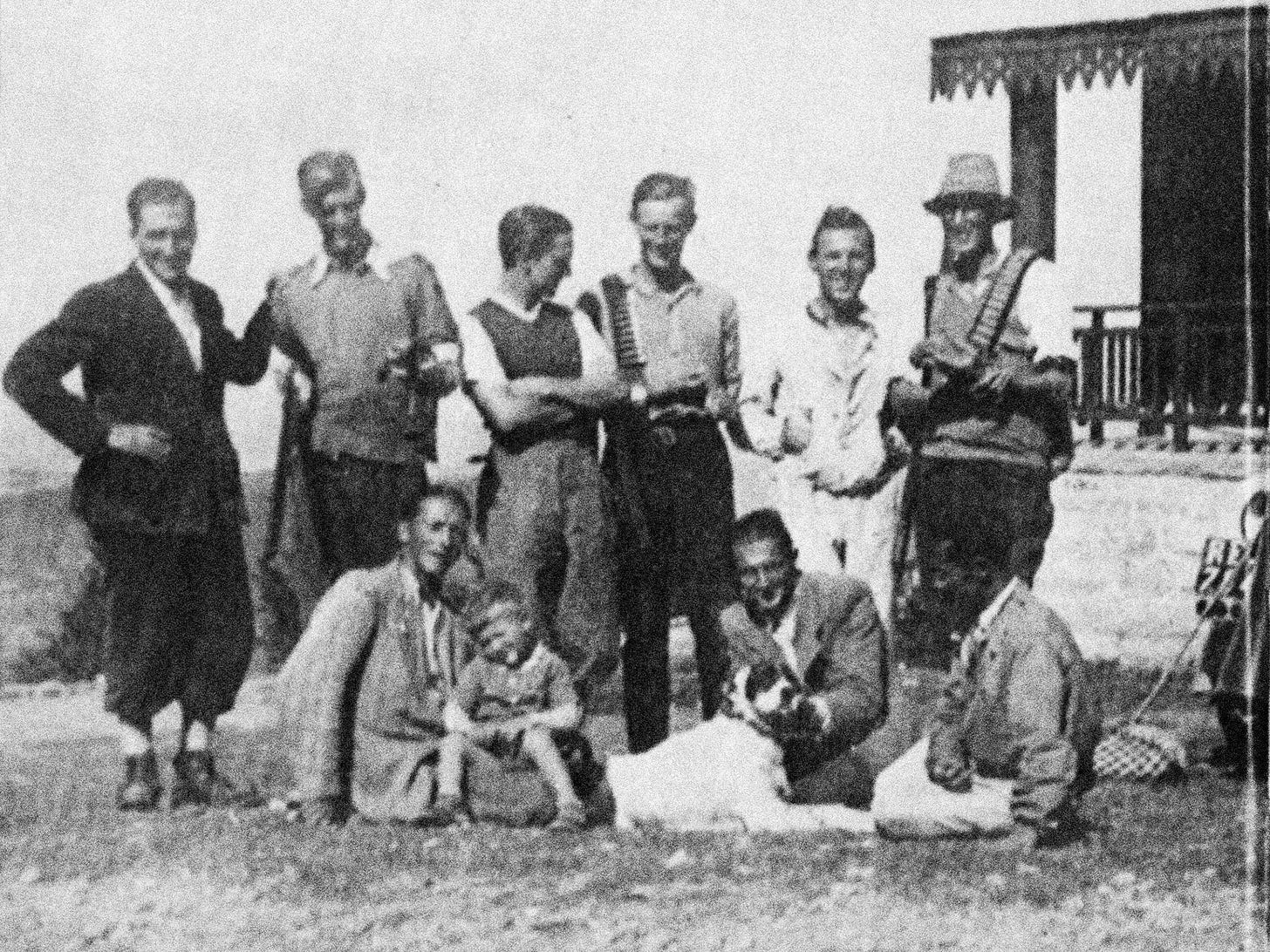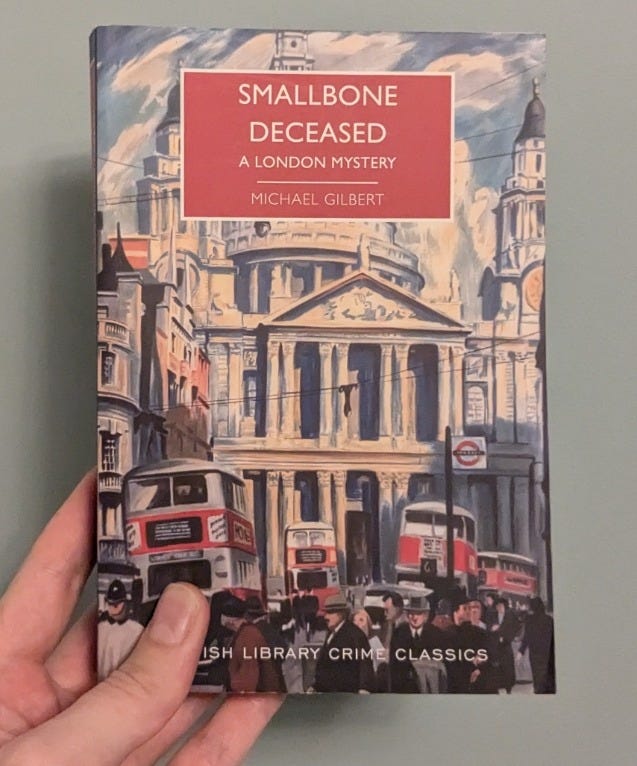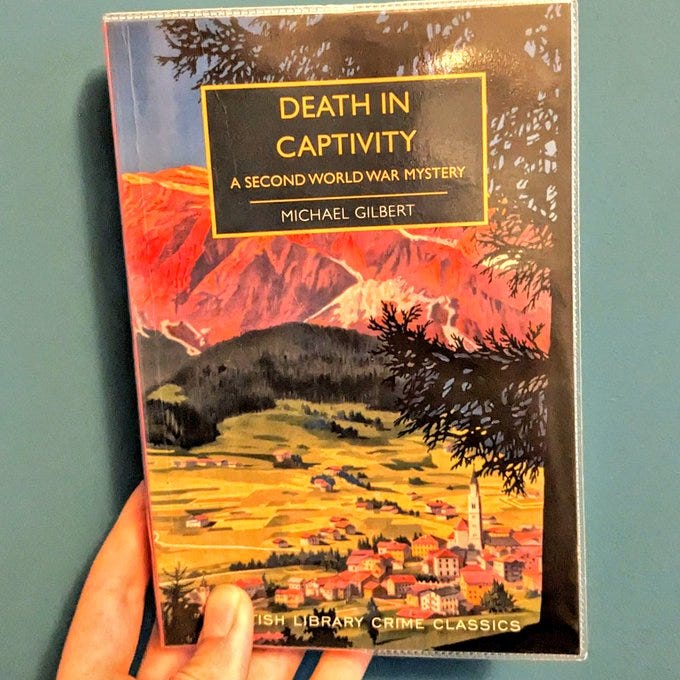Few crime writers make a living from crime writing alone. Many have to fit their literary ambitions around another job. Unsurprisingly, these moonlighters have occasionally drawn on their other occupational experiences for inspiration. Railway engineer Freeman Wills Crofts loved writing about train timetables, composer Edmund Crispin explored the world of music in a few of his novels, the Reverend Victor Whitechurch created a vicar-detective in Crime at Diana’s Pool, and Agatha Christie used her time as a secret international spy as inspiration for the Tommy and Tuppence books.1
One writer who made good use of his CV was soldier-turned-solicitor Michael Gilbert, who composed his novels on his daily London commute.2 Gilbert found inspiration in both his wartime army experiences and his peacetime legal career. I’ve recently enjoyed an example of each of these, both republished by the British Library: Smallbone Deceased (1950) and Death in Captivity (1952). I’ve written my thoughts below, which you might like to read on your daily commute (unless, of course, you drive to work, in which case you can send me a message and I’ll record a version you can listen to through your car’s audio system).
Smallbone Deceased (1950)
The respected offices of Horniman, Birley and Craine become a crime scene when Mr Smallbone is discovered inside a large deed box. As you might guess from the title, he’s no longer alive. Inspector Hazlerigg is called in to investigate, with inside assistance from newly-qualified solicitor Henry Bohun, who had previously appeared in a 1948 short story in Good Housekeeping.
The book opens with a “these characters are entirely imaginary” disclaimer, which is especially pertinent because Gilbert himself worked in Lincoln’s Inn, where the fictional offices of Horniman, Birley and Craine are situated. Gilbert’s legal career had only begun properly a few years previously — he completed his law degree in 1937, aged 25, but his career progress was disrupted by the outbreak of World War II. After the conflict was over, he joined a firm of solicitors, remaining in the same workplace until his retirement in 1983. His real-world experience definitely adds authenticity to the setting of Smallbone Deceased.
I will say at this point: I think this book is overrated. It has regularly been hailed as one of the greatest crime novels of all time, appearing on multiple “best books” lists, including those of the Crime Writers’ Association and Mystery Writers of America. I really don’t think it’s quite that good.
But it is still very good. Gilbert is an excellent writer, both in his plotting and his prose. There are some clever pieces of misdirection, and some good hidden-in-plain-sight clues. The characters are interesting, and I especially enjoyed the respectful relationship between the amateur Bohun and the professional Hazlerigg — who warns detective fiction reader Bohun that he’s not going to act like the inspectors do in novels. Sadly, I feel the mystery was let down by a slow-paced final third, and Gilbert could have made more of the unusual body-disposal method. So, not one of the 100 best crime novels ever, but still a very good one.
Verdict: ⭐⭐⭐⭐ (4/5)
You can buy Smallbone Deceased from The British Library or from your favourite independent bookshop.

Death in Captivity (1952)
In my last post, I discussed the locked room master John Dickson Carr. In Death in Captivity, Michael Gilbert explores a locked-room scenario that Carr overlooked — a dead body in a sealed Prisoner of War escape tunnel. H. R. F. Keating claimed this is “surely the only whodunnit set in a prisoner-of-war camp.”3 This unusual setting becomes the focus of an intriguing mystery, based on real-life events.
Gilbert served with the Honourable Artillery Company during the war, which was ok until he was captured as a prisoner of war in 1943 and interned in an Italian camp. Later in the year, he was part of a group of prisoners that escaped, making a 500-mile journey to safety. This successful escape was later documented by fellow escapees Eric Newby, in his 1971 memoir Love and War in the Apennines, and Tony Davies, in his When the Moon Rises. Michael Gilbert decided to use the experience as fictional inspiration, resulting in this book and its 1959 film version, Danger Within.4
The premise for Death in Captivity would be interesting in itself, but Gilbert’s personal experiences add authentic colour to the story, making the mystery even more engaging. Gilbert makes good use of the closed-circle setting, as well as the unusual locked-room set-up. When the solution is revealed, it’s the sort of ending where I immediately wanted to look back and reread sections knowing who the murderer is. Even if you don’t find the wartime context immediately appealing, I’d definitely recommend giving this a read. It’s an excellently unusual whodunnit.
Verdict: ⭐⭐⭐⭐ (4/5)
You can buy Death in Captivity from The British Library or from your favourite independent bookshop.

These two books were my first taste of Michael Gilbert, who had a very varied crime writing output. Have you read any of his other novels? What did you think?
This last example may not be true. Or, at least, that’s what my boss at MI6 has told me to say.
One of many interesting details in H. R. F. Keating’s obituary for Michael Gilbert in The Guardian, which you can read here.
In the obituary referenced above.







Thanks, Adam. I always enjoy your posts.